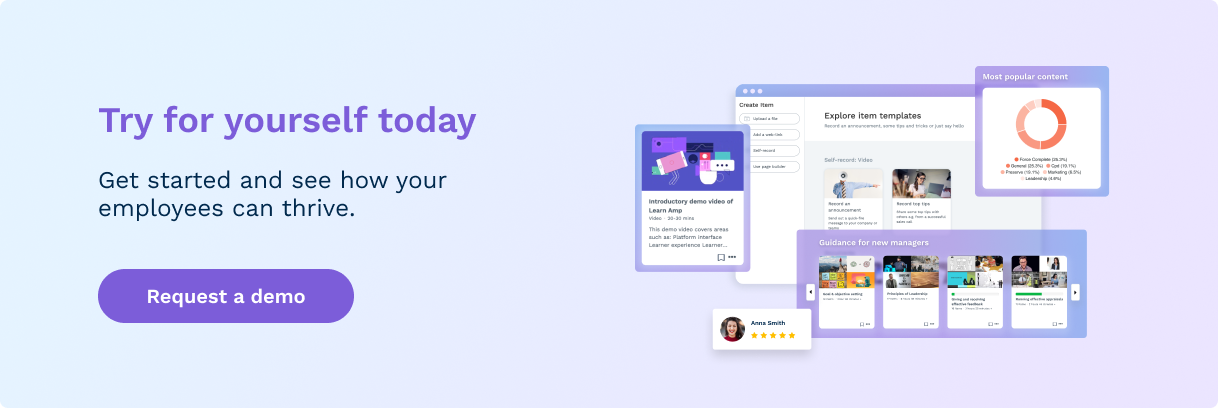Getting the onboarding process right is absolutely critical. Poorly onboarded employees are less productive, less satisfied, and more likely to leave [1]. But how can you make sure your onboarding process still works when you’re doing everything remotely?
Suddenly, you can’t count on the usual meet-and-greet, your comfortable offices, or your in-person training sessions to make new hires feel like part of the team. So what can you do to give new recruits a great employee experience despite the tricky circumstances?
Here are a few ideas:
1. Involve the Hiring Manager
Gallup research has shown that 70% of the difference between employee engagement and disengagement comes down to the manager. This is true whether or not your managers are dealing with their teams in person or via Zoom. The difference with remote onboarding is that it can be very easy for new staff to slip through the cracks—out of sight, out of mind.
To solve this issue, make sure that you update your onboarding process and communicate it to all involved. Managers are likely to be even more busy than usual—coping with queries from staff, the complications of working from home, the challenges of a global financial crisis, and so on. It will, therefore, be helpful to convey which aspects of onboarding are owned by HR, and which are the responsibility of the manager.
It may be as simple as requiring all managers of new staff to conduct weekly digital check-ins or one-to-one calls via Zoom, or you might need to consider adding employee onboarding metrics to their usual KPIs. Hubspot reports that 78% of companies investing in onboarding reported increasing revenues—so this is definitely something that’s worth time and effort [2].
2. Buddy Up
Normally, you can count on new staff members having daily contact with their colleagues, both professionally and personally. A lot of informal onboarding takes place in the office cafeteria. However, when you move to remote onboarding, you may have to formalise this process. An onboarding “buddy” system can be incredibly helpful.
Your choice of buddy should reflect your global HR strategy. If your priority is to get new hires up to speed as quickly as possible, you’ll be best off with a buddy in a similar role who can answer task-related queries.
If you’re more concerned about creating a cohesive employee experience, you might want a buddy who can help explain the company culture or any unwritten rules that the new hire should be aware of. If you’re working under stressful conditions at the moment, the buddy could be more of a peer mentor who can offer support and a listening ear.
3. Use KPIs During Onboarding
When they’re just starting out, it can be hard for new hires to know what they should prioritise. Feeling like you’re floundering or out of your depth can be deeply un-motivating. What’s more, without monitoring, new employees may not receive the training they need to be productive.
The problem gets worse when you’re not all in an office together—you simply won’t see the employee looking lost or bored.
To keep new hires engaged, on track, and feeling like they’re making progress, you need to build a system to track their performance as part of the onboarding process. They should have KPIs or similar targets that are challenging but not overwhelming. These should be reviewed frequently by their manager to make sure that their development and engagement remain high.
1 in 5 new hires fail their probation period—and 62% of those failures are put down to poor performance. But if performance issues can be caught and fixed in Week 1, you’re far less likely to lose the employees you spent time and money acquiring.
Technology is your friend here. If you’re still handling your onboarding processes manually, now is the perfect time to build automated systems to ensure every employee starts off on the right foot. With a tool like Learn Amp, you can create automated onboarding pathways for new hires with milestones, KPIs, and self-serve training content to keep new employees moving forward without getting flooded with too much information.
4. Build Your Corporate Brand Into Your Training Programs
Too many companies rely on dull, standardised training materials. This matters less when new employees are coming into the office, they can soak up the corporate culture and learn from coworkers they sit next to, as well as from the training content. However, if you’re moving to remote onboarding, you may want to up your training game.
Your training materials should not only focus on specific tasks, you should also make your unique way of working part of the training process. Training should be positioned in the context of overall company goals. Your employees need to understand why they need to learn the information, not just what they need to learn. Reinforce your company values throughout your training process to ensure that new hires keep your mission and way of working front of mind.
You might also want to consider ways to build training into the overall performance management system. By tying training progress into their personal development plans, you can also help new hires see how their efforts in the early days can contribute to longer-term progression, thus creating clear incentives for engaging with the learning process.
5. Get Social
Socialising is an unofficial but crucial part of the employee onboarding experience. Studies consistently show [3] that work friendships increase employee satisfaction, engagement, collaboration, even creativity. Remote working makes building these personal connections harder, but certainly not impossible.
Companies can help new hires feel like part of the team by offering online social events, setting up “water cooler” Slack groups for off-topic chat, running digital video challenges, or providing free workshops on non-work topics. Some best practice tips:
- For group conference calls, even those with a social focus, providing some structure will keep things inclusive for all participants.
- Try to include multiple departments to help new hires feel like part of a wider organisation rather than just a member of a small team.
- Remember that, while some employees may have too much time on their hands at the moment, others may be juggling childcare or other responsibilities without support so make sure that social events remain fun and not a source of stress.
Remote onboarding can be challenging, but, if you get it right, you can make sure that your new hires are more engaged, more motivated, more productive - and happier.
References:
[1] 50 Onboarding Statistics to Improve the Employee Experience





